1. Introduction
In this tutorial, we’ll learn about “The Readers-Writers Problem”. This classic synchronization problem explores the challenges of coordinating multiple reader and writer threads accessing a shared resource. We’ll first present the problem statement, discuss potential solutions, and analyze their advantages and limitations.
2. Common Variations of the Readers-Writers Problem
The readers-writers problems in computer science are widely recognized as a significant challenge in concurrent programming. These problems emerge when multiple threads within a program or system concurrently seek to access a shared resource.
The crux of the issue lies in ensuring proper synchronization and coordination among the threads to prevent conflicts and maintain data integrity. At least three distinct variations of the readers-writers problem exist, each specifically designed to handle different scenarios where concurrent threads contend for access to the same resource:
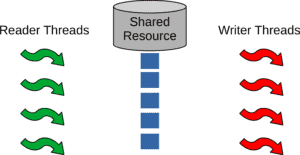
These variations address the complexities that arise when multiple entities simultaneously read from and write to a shared resource, necessitating careful consideration of concurrency control mechanisms and fair access policies.
2.1. The First Readers Writers Problem
Multiple readers can access the shared resource simultaneously, but writers must have exclusive access. For instance, when multiple users are accessing a database, they can retrieve information simultaneously, but only one user can update or modify the database at any given moment:
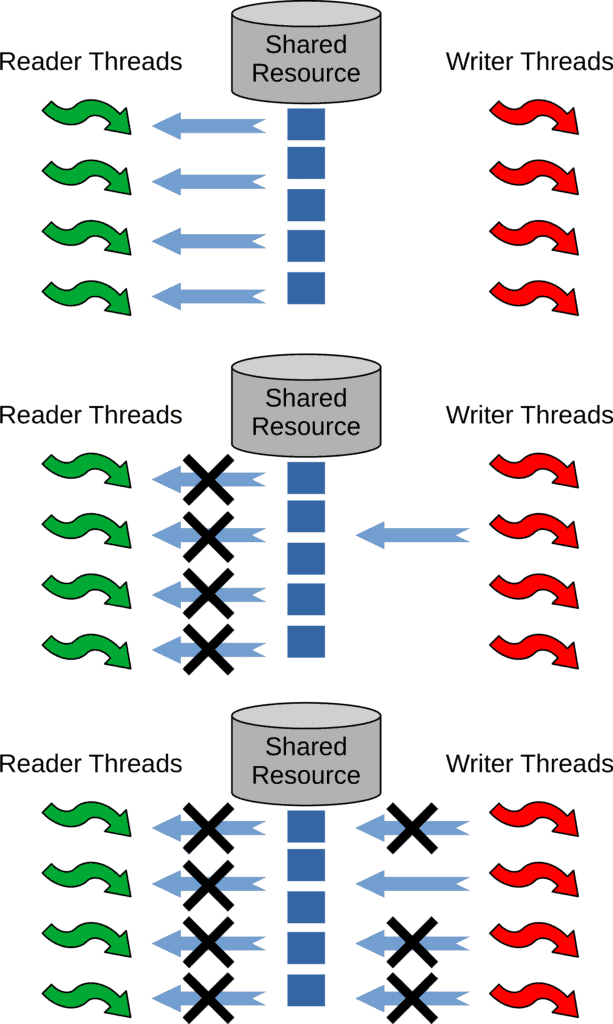
2.2. The Second Readers Writers Problem
Readers can access the shared resource simultaneously, even if a writer is currently accessing it. However, writers still require exclusive access. For example, when several users are accessing a shared document, they can view its content simultaneously while a single user is making edits or writing to the document:
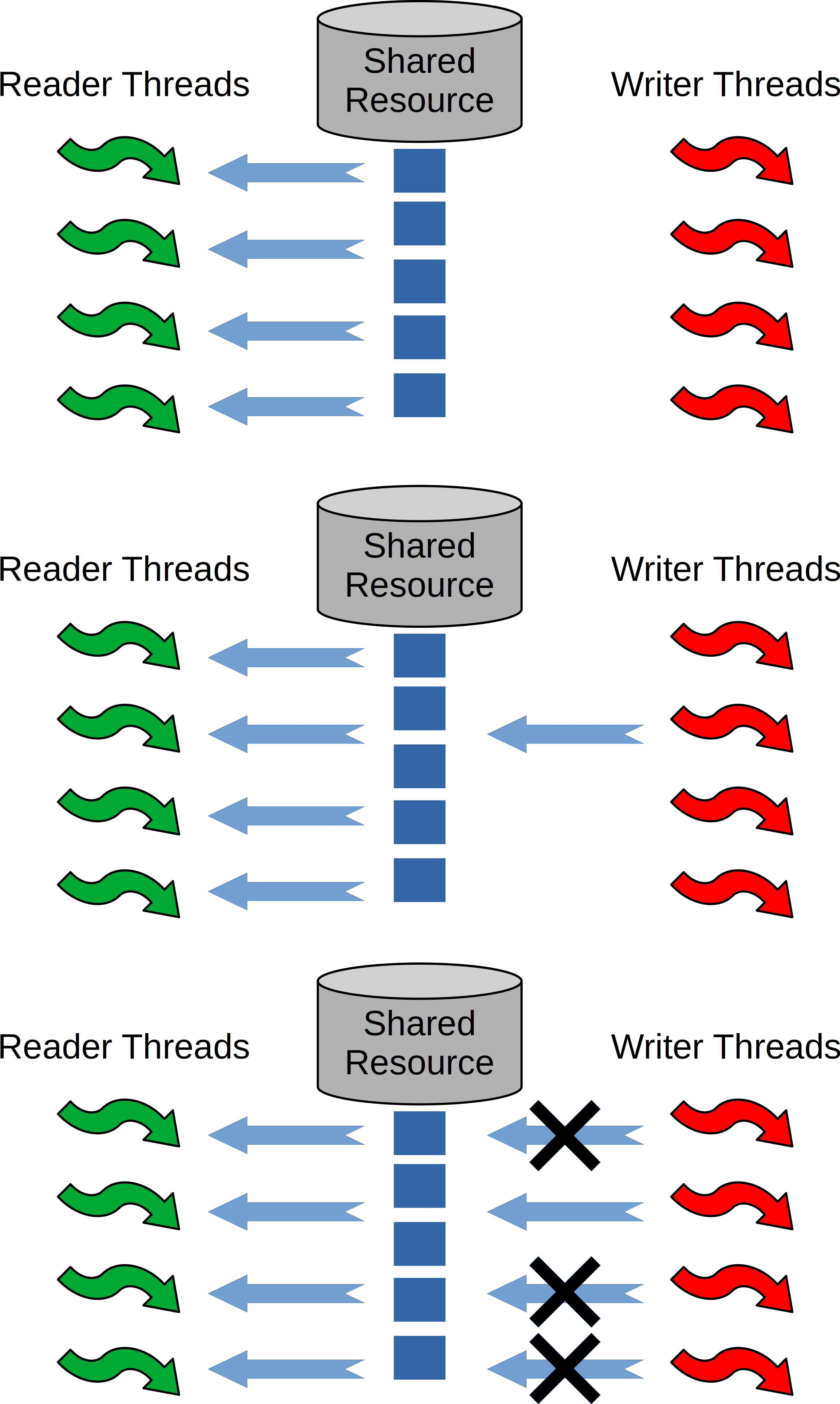
2.3. The Third Readers Writers Problem
Both readers and writers can access the shared resource simultaneously without any exclusive access requirements. This scenario is commonly encountered in systems where data is temporarily stored in a buffer or cache, such as web servers or streaming applications:
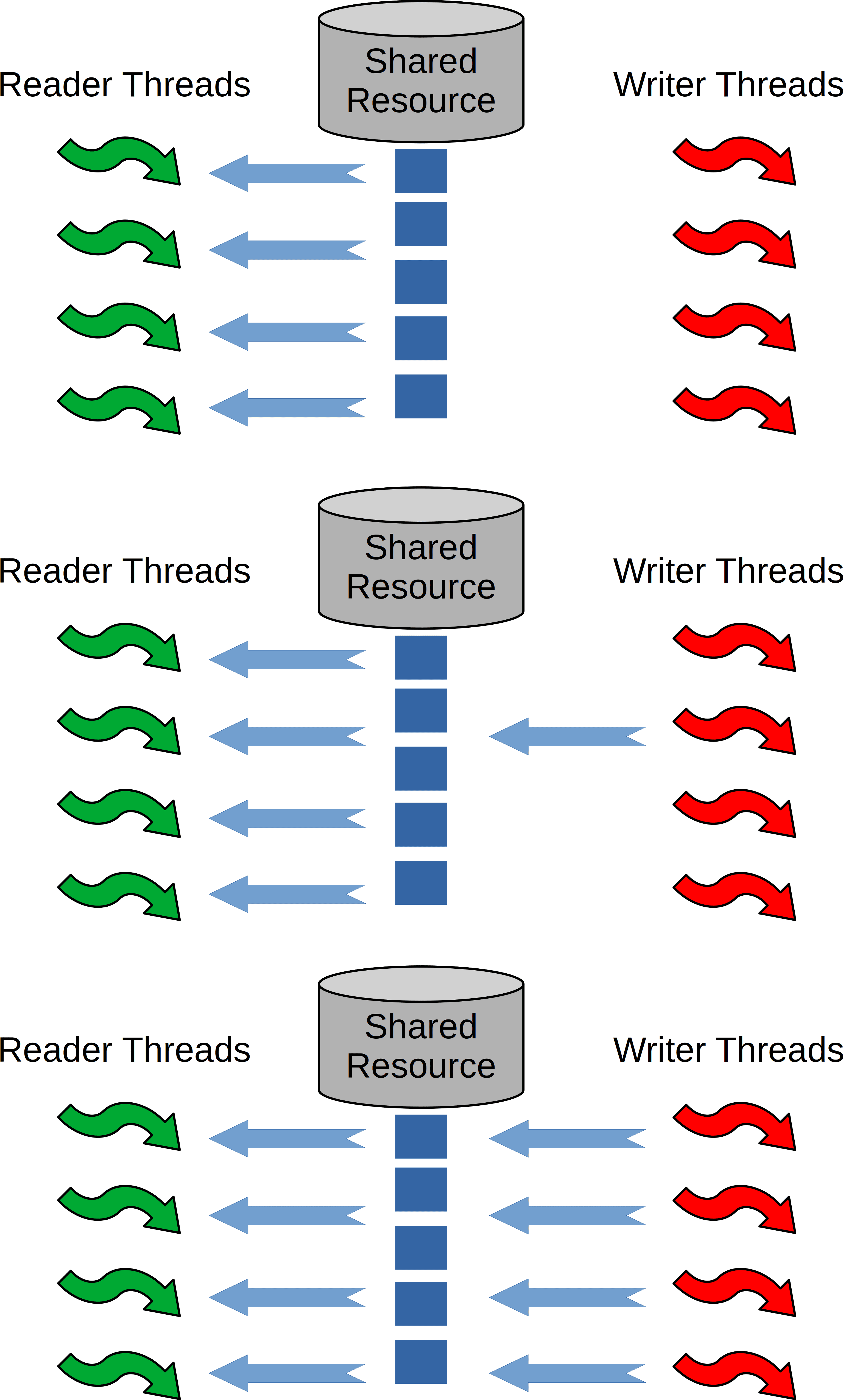
3. Concurrency and Fairness
Concurrency and fairness are crucial aspects when considering solutions to the readers-writers problem. Concurrency ensures that multiple threads can access the shared resource simultaneously, maximizing system throughput and responsiveness. By enabling concurrent access, solutions can handle a higher volume of readers and reduce potential bottlenecks.
Fairness, on the other hand, ensures that both readers and writers have fair opportunities to access the shared resource. Fairness prevents starvation and ensures that threads are not unfairly delayed or blocked indefinitely.
While maximizing concurrency is desirable to improve system throughput, it should not come at the expense of fairness, as it may lead to unfair starvation or delay of certain threads. Striking the right balance between concurrency and fairness ensures efficient utilization of resources while maintaining equitable access for all threads, promoting a stable and responsive system.
4. Common Solutions to the Readers-Writers Problem
Several common solutions to the Readers Writers Problem provide different approaches to synchronize access to the shared resource. These solutions offer varying levels of concurrency and fairness, enabling efficient coordination between multiple reader and writer threads.
4.1. Read-Write Locks
This solution uses a read-write lock mechanism to control access to the shared resource. Multiple readers can acquire the read lock simultaneously, allowing concurrent read access. Writers, on the other hand, acquire an exclusive write lock, ensuring exclusive access. This approach prioritizes concurrent reading while providing exclusive access to writing:
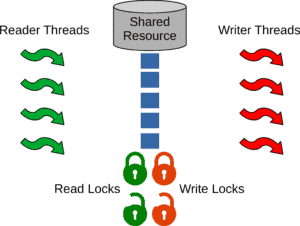
Read-Write Locks provide high concurrency for readers, allowing multiple threads to read simultaneously. However, they may not offer fairness to writers, as a writer could potentially be indefinitely delayed if there is a continuous influx of readers.
4.2. Semaphore-based Solutions
Semaphore-based solutions use semaphores to control access to the shared resource. Readers and writers acquire and release semaphores to regulate their access. These solutions typically involve maintaining counters or flags to keep track of the number of readers and writers currently accessing the resource:
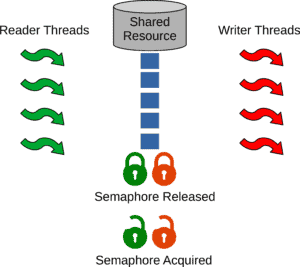
Semaphore-based solutions can provide good concurrency for both readers and writers, depending on the implementation. By adjusting the semaphore values and managing the signalling mechanism, we can achieve fairness by ensuring that readers and writers have equal opportunities to access the shared resource.
The diagram below illustrates the utilization of locking-based mechanisms, including semaphore-based locking, in the different variations of the readers-writers problem:
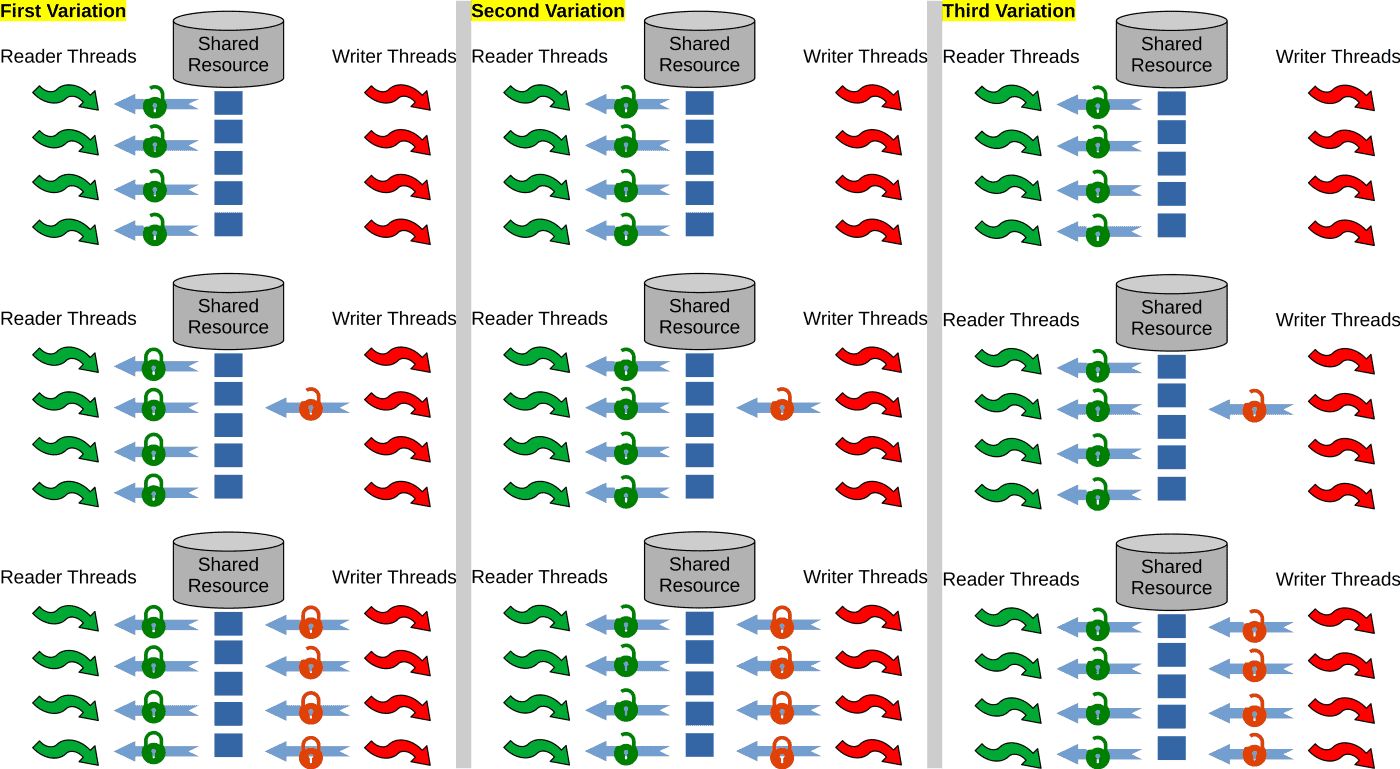
4.3. Monitors
Monitors are higher-level synchronization constructs that encapsulate shared data and the associated synchronization operations. They provide methods for readers and writers to interact with the shared resource in a mutually exclusive manner. Monitors ensure that only one thread accesses the resource at a time, either for reading or writing:
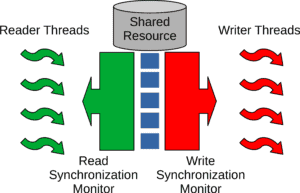
Monitors, while ensuring mutual exclusion and data integrity, typically prioritize fairness over high concurrency. Only one thread can access the shared resource at a time, reducing overall concurrency. However, they provide fairness by giving each thread an equal chance to access the resource, preventing starvation.
4.4. Read-Preferring or Write-Preferring Solutions
Some solutions prioritize either readers or writers based on the system’s requirements. Read-preferring solutions allow multiple readers to access the resource concurrently, granting writers exclusive access only when there are no readers. Write-preferring solutions prioritize writers, allowing them immediate access to the resource and temporarily blocking readers:
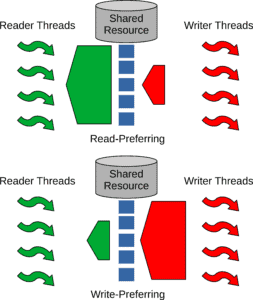
Read-preferring solutions offer high concurrency for readers by allowing multiple simultaneous reads. However, fairness may suffer for writers as there might be ongoing readers. Write-preferring solutions prioritize writers, ensuring faster access for writers but potentially reducing concurrency for readers, which may impact overall fairness.
5. Scalability in the Readers-Writers Problem
Scalability presents significant challenges in the Readers-Writers Problem. As the number of concurrent threads accessing the shared resource increases, ensuring efficient and equitable access becomes more complex.
Read-Write Locks and Semaphore-based solutions have the potential for good scalability when there is a significant number of readers. Monitors may have limited scalability due to their mutual exclusion nature. Read-preferring or write-preferring solutions can be scalable, depending on the specific requirements and the balance between readers and writers.
Balancing the needs of readers and writers becomes crucial to avoid starvation or unfair delays. Additionally, maintaining data consistency and avoiding race conditions while scaling the solution adds further complexity. Achieving optimal scalability requires careful design and implementation choices to handle increasing workloads and varying patterns of access in a balanced and efficient manner.
6. Conclusion
In this article, we learned that the Readers-Writers Problem is a classic synchronization challenge that explores the coordination of multiple reader and writer threads accessing a shared resource. The problem has various variations, each addressing different scenarios of contention for resource access.
Concurrency and fairness are essential considerations when designing solutions, as they impact system throughput and ensure equitable access for all threads. Common solutions like Read-Write Locks, Semaphore-based approaches, Monitors, and Read-Preferring/Write-Preferring solutions offer different levels of concurrency and fairness.
Scalability poses challenges, requiring careful management of synchronization mechanisms and access patterns to handle increasing thread concurrency effectively. Achieving optimal scalability involves maintaining data consistency and considering the specific requirements and trade-offs of the system.
